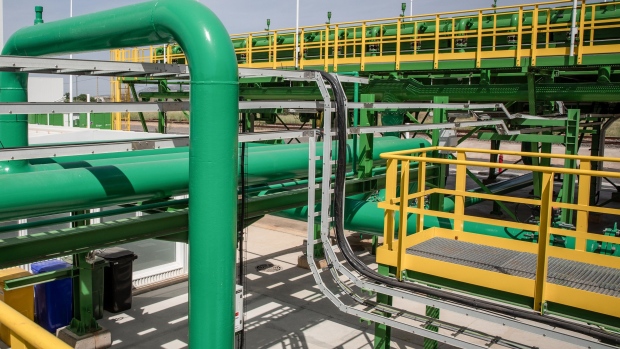Jun 15, 2022
BP's $36 Billion Project Highlights Massive Green Hydrogen Hubs
, Bloomberg News

(Bloomberg) -- BP’s acquisition of a stake and lead role in a $36 billion green hydrogen development in Western Australia is casting a spotlight on a slew of ambitious projects around the world that are promising to deliver massive amounts of the clean fuel.
Green hydrogen, produced using water and renewable electricity, is widely predicted to play a crucial role in the decarbonization of heavy industry, such as steelmaking, and is forecast to grow rapidly this decade. Global output could jump as much as 18-fold to about 11.6 million tons a year by 2030 with strong policy support, according to BloombergNEF.
In addition to the Asian Renewable Hub, in which BP will take a 40.5% share, massive developments are being mooted everywhere from Texas to Kazakhstan and Oman, drawn by the allure of cheap and abundant clean energy. Wood Mackenzie Ltd. forecasts that demand for low-carbon hydrogen could surge to as high as 600 million tons a year by 2050 from less than 1 million tons now.
The hubs that succeed will be the ones that are able to find buyers for their hydrogen, while governments also have a big role to play in offering policy incentives that encourage the switch from fossil fuels, said Martin Tengler, an analyst at BloombergNEF. “Hubs with one or more large, guaranteed offtakers, are much more likely to come to fruition.”
Here are some of the projects being proposed. The capacity figures for the two Australian and the Oman hubs are from the International Renewable Energy Agency, while the others are from the company’s themselves.
Asian Renewable Energy Hub
-
Location: Western Australia
-
Planned hydrogen capacity: 14 GW
The AREH, which would use electricity from wind and solar plants stretched across thousands of miles of West Australian desert, aims to produce about 1.6 million tons of green hydrogen, or 9 million tons of green ammonia, for domestic use and export. In addition to BP, investors include InterContinental Energy Corp., CWP Global and Macquarie Group. Intercontinental said the partners are targeting a final investment decision by 2025.
Texas Hydrogen City
-
Location: Corpus Christi
-
Planned hydrogen capacity: 60 GW
Green Hydrogen International Corp., run by by renewable energy entrepreneur Brian Maxwell, announced the world’s largest planned hub for the fuel in March. The project will be able to produce more than 3 million tons of green hydrogen a year. The fuel will be generated from wind and solar and be stored in caverns at the Piedras Pintas Salt Dome, and then delivered by pipeline to ports at Corpus Christi and Brownsville. The first phase of the hub is expected to start operations in 2026.
Svevind Kazakhstan Project
-
Location: Kazakhstan
-
Planned hydrogen capacity: 30 GW
Svevind AB, the closely held company behind Europe’s largest wind farm in Sweden, signed agreements last year with Kazakhstan’s government and national investment arm to build up to 30 gigawatts of electrolyzers backed by 45 gigawatts of renewable energy capacity to produce about 2 million tons a year of green hydrogen. Statements from the company and government officials in the central Asian nation didn’t describe potential uses or export avenues for the fuel.
Western Green Energy Hub
-
Location: Western Australia
-
Planned hydrogen capacity: 28 GW
Announced in July 2021, the proposed hub, could cost as much as A$100 billion ($69 billion). It would use wind and solar to generate power and would cover an area half the size of Belgium. Also backed by Intercontinental Energy, the project would produce as much as 3.5 million tons of green hydrogen or 20 million tons of green ammonia each year for domestic use and export.
Green Energy Oman
-
Location: Oman
-
Planned total capacity: 14 GW
An international consortium including Oman’s government-owned petroleum investment company OQ and the ubiquitous InterContinental Energy plan to build massive wind and solar arrays in the Middle Eastern desert and “produce millions of tons” of green hydrogen annually. The group said the site’s strategic location between Europe and Asia would position it to offer a reliable supply of green fuels globally at a competitive price.
AquaVentus
-
Location: Offshore Germany
-
Planned hydrogen capacity: 10 GW
In the icy blue waters around the island of Heligoland off Germany’s North Sea coast, the AquaVentus initiative plans to use power from offshore wind farms to operate electrolyzers also installed at sea. The goal is to have a total capacity of 10 gigawatts by 2035, enough to produce 1 million tons of green hydrogen a year. Partners in the venture include RWE AG, Shell Plc, the Island of Heligoland and Siemens AG.
©2022 Bloomberg L.P.





